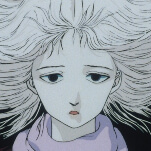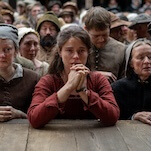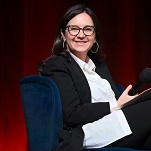When it comes to inspiration for a cosmic superhero, a writer can do far worse than Doctor Who. Dan Slott is an avid Whovian, and for his new Silver Surfer series with artist Mike Allred and colorist Laura Allred, he pulls the Doctor/Companion dynamic from the beloved British sci-fi series to bring a sense of humanity to the adventures of Norrin Radd, a man who travels the cosmos on a shiny surfboard. Continuing an impressive streak of All-New Marvel Now! debuts, Silver Surfer #1 (Marvel) is a breathtaking trip through micro-star systems and impossible cities, beginning the series with unbridled imagination and true all-ages appeal.
This first issue greatly benefits by splitting focus between the Surfer and new character Dawn Greenwood, the homebody manager of a bed and breakfast in Anchor Bay, the idyllic town with the motto “You Are Here” because it had the first postcard to say “Wish you were here.” Dawn is the identical twin and polar opposite of her sister Eve, a globe-trotting cosmopolitan who sends her sister pictures from all the exciting locales she visits, and establishing the relationship between the two sisters makes this more personal than the typical Silver Surfer tale. Mike Allred does great work immediately establishing the differences between the two sisters in their designs: Dawn is outfitted in a red dress with black dots that connects her to the sedentary ladybug while Eve wears yellow and black stripes that connect her to the more active bumblebee.
Dawn is a character that looks outside her window and sees the same thing everyday and is totally happy with that, but there’s a pang of jealousy whenever she sees her sister’s pictures. Little does she know that she’s about to be whisked away to places she’d never dreamed of visiting when alien interference forces her to cross paths with the Surfer. There’s a surprising tenderness to Slott’s story, which begins with Dawn wishing on a shooting star that turns out to be the Silver Surfer in flight. That moment creates an almost mystical bond between the two characters that they’re unaware of, and the final pages of this issue set up a very fun dynamic for the two as the series moves forward. Slott provides all the necessary exposition to catch new readers up on the Surfer’s history—he used to work for the universe’s Big Bad, now he’s a good guy—but this issue isn’t concerned with the past. Instead it paves an exciting future for the character, one of infinite possibilities thanks to Slott’s anything goes story and the Allreds’ astoundingly creative artwork.
The retro, Jack Kirby-inspired art of Mike Allred is the perfect fit for the Silver Surfer, and Laura Allred’s vibrant palette uses every color in the rainbow to emphasize the youthful whimsy of the story. The opening pages showing Dawn and Eve as children are dominated by a dark blue that is typical of a night in a beachside Earth town, but things become brighter as the Surfer enters the picture, segueing into a candy-colored shot of Radd in the present rekindling a star in a micro-star system. There’s a strong contrast between Dawn’s relatable domestic world and the fantastic locales and creatures Radd encounters, and when the Allreds have the opportunity to go all-out with outer space visuals, they do it. (One particularly wacky image: giant snowflower slaloms that are pollinated by skiers.)
The highlight of this first issue is an awe-inspiring two page spread revealing The Impericon, a planet-sized “Impossible Palace” that takes Kirby’s architecture design sense and amplifies it to new levels of mind-bending intricacy. The framing of the shot accentuates the magnificent grandeur of the location and Laura Allred’s psychedelic coloring is both wildly varied and remarkably specific. It’s such an intricate image that it’s easy to spend minutes staring at all the details in the linework and colors, and if this is the level of work the Allreds deliver at the start of this series, it’s impossible to guess the heights they’ll reach once the story kicks into high gear. The Silver Surfer hasn’t had much luck with solo series in the past, but the concept and creative team of this new ongoing make it one of the year’s most promising new titles… [OS]
After a four-month delay caused by a major creative shift that replaced writer Matt Fraction with Charles Soule, Marvel’s
Inhuman finally hits stands to continue the event that has already come and gone in the publisher’s other titles.
Inhuman #1 (Marvel) teams Soule with artist Joe Madureira and colorist Marte Gracia for a story that looks at the immediate effects of the Terrigen bomb unleashed by Black Bolt way back in last September’s
Infinity #3, continuing the narrative by checking in with Inhuman queen Medusa and two new characters: Lash, an Inhuman with the ability to absorb the Terrigen from other members of his species (and kill them in the process), and Dante, a family man from Des Plaines, Illinois, whose life changes forever when he’s transformed by the Terrigen mists.
Beyond Medusa, most of the established Inhumans are absent as Soule spends his time spotlighting fresh faces, a strategy that helps establish personal stakes for a selective few, but also makes the Inhuman world feel surprisingly small considering the scope of the narrative. Granted, Inhuman history isn’t particularly accessible for new readers, so it’s wise for Soule to ease into the story. Future issues will be shifting focus to different parts of the Inhuman community to make this book more of an ensemble piece, and taking the time to give readers an understanding of individual characters at the start will prove beneficial as the cast expands.
Madureira has developed a reputation for dynamic, manga-inspired artwork, with a design sense that is heavily influenced by Japanese video game aesthetics. His look for Lash, with his lack of a shirt and long spiky hair, would be right at home in a Street Fighter game, but it’s a bit bland when compared to the work of Inhumans co-creator Jack Kirby. Madureira fares very well with the more eccentric designs of Medusa and Eldrac, an Inhuman that is a living door, and he does particularly impressive work with Medusa’s hair, using it as a graphic flourish that adds flowing motion to the static images.
Gracia applies colors directly to Madureira’s pencils, and while that technique has washed out Madureira’s art in the past, Gracia uses strong, saturated tones that provide extra definition. He uses warm and cold tones to create contrast on the page, exaggerating the two ends of the spectrum during the fight scene at the end of the issue to amplify the tension of Madureira’s kinetically staged action. Inhuman #1 isn’t a complete home run, but there’s enough that works here to suggest that the series will be worth the wait… [OS]
The first issue of Francis Manapul and Brian Buccellato’s
Detective Comics run begins by introducing two people finding a new start in Gotham, a sequence that could easily be describing the two creators as they move from
The Flash to the title that gave Batman his start. Manapul and Buccellato are credited as “storytellers,” sharing writing duties, while Manapul draws and Buccellato colors the artwork, and their tight collaboration results in some spectacular sequences in
Detective Comics #30 (DC).
The plot of this issue involves Batman fighting a motorcycle gang that is putting a dangerous new drug on the street, while Bruce Wayne enters a new business partnership to develop Gotham’s crime-ridden, impoverished East End. It’s not groundbreaking by any means, but it ties in with ongoing Batman plot threads (the rebuilding of Gotham, Bruce’s grief over losing his son) without becoming inaccessible to new readers, and builds strong forward momentum for this opening arc. Manapul has grown into one of the most confident, innovative artists currently working at DC, and his layouts do exceptional work staging action while evoking the harsh atmosphere of Gotham City, essential elements of any successful Batman story.
Manapul has an impeccable understanding of the medium’s strengths, often breaking a single image into individual panels that highlight specific moments, creating the illusion of time passing within one expansive visual. His composition smoothly guides the eye across these clever layouts, best evidenced in a two-page sequence where Batman uses his grappling line to take down the aforementioned biker gang. FCO Plascencia’s vivid, unconventional coloring palette on Batman has elevated that book’s artwork, and Buccellato takes a similarly diverse approach to his work on Detective Comics, using a wide array of colors that mingle beautifully with Manapul’s texture ink washes. The creators are clearly taking advantage of this new start to push themselves, and hopefully DC editorial gives them the freedom to experiment and fully explore their potential… [OS]
The graphic memoir has really come into its own over the years, and Mimi Pond explores her own coming-of-age story with the fictionalized memoir
Over Easy (Drawn And Quarterly). Pond, a cartoonist whose works have appeared in major outlets and who is best-known for writing the very first episode of
The Simpsons, takes us back to 1970s California, where her younger self, known as Madge Pond, has been going to art school but finds herself at a crossroads when she can’t afford her final year at college. She begins to work at a restaurant, first as a dishwasher and then as a waitress, getting to know the idiosyncratic cast of characters who work alongside her.
Rather than being a story with a very specific and fast-moving plot, Over Easy instead functions as a character study, a humorous look into the inner dramas and realities of work, and a snapshot into life in the Bay Area during the late ’70s. Pond uses gentle humor to show the different characters in the restaurant, including her boss Lazlo, who won’t hire anyone unless they can impress him with a good joke or a good dream, and Sammy, the cook who is convinced he’s really a poet, despite Madge insisting that he can’t write poetry. While the characters are quite unique and distinct, she easily and accurately nails down the many dilemmas and feelings familiar to anyone who has had a job.
Though much of the book concentrates on the work scene, it also dips into other areas of Madge’s life, like her search for relationships and her experiences with different men. (While their relationship is short-lived, the lover who calls himself “the first Western avatar” is priceless.) She also watches in as other characters try to take charge of their love lives, acting as an audience at the same time the reader is. Pond illustrates these events in cartoonish, expressive style, using the same color scheme of greens, white and black that’s seen on the cover. While the pictures themselves stick to just these few hues, the story and characters of Over Easy are bursting with color… [DD]
Bryan Hitch has made a career for himself as one of the most cinematic artists in comic books, so much so that his work on Marvel’s
The Ultimates set the visual foundation for Marvel Studios’ films. That influence comes full circle in Hitch’s writing debut,
Real Heroes #1 (Image), a hybrid of Joss Whedon’s
The Avengers and
Galaxy Quest that follows six superhero film actors who find out they’re the Earth’s only hope against galactic conquerors. This first issue is largely about contrasting the everyday personas of these actors with the characters they play, placing an emphasis on how people like first responders and paralympic athletes are “real heroes,” while these performers and their fictional counterparts are manufactured for entertainment.
Hitch covers a lot of ground in this introduction, but much of the information comes via hefty exposition that clutters the page and pulls attention from the artwork, the source of most of the book’s appeal. Hitch is an artist that doesn’t shy away from celebrity likenesses for his characters, but that works for a book about a group of actors; in this issue he uses Bradley Cooper and Michael Rosenbaum’s faces and includes a cameo from Chronicle director Josh Trank, who appears as himself to direct Olympians 2: Devastation. The action sequences are breathtaking, and the amount of detail in each panel reveals why Hitch has developed a reputation for making superhero stories feel real. His art is strong enough to tell a story without getting buried in text, and embracing a “less is more” philosophy with his scripting would help make the book a smoother read… [OS]
And…
Wolves are often portrayed as mysterious creatures in stories and legends, and the manga Wolf Children Ame & Yuki (Yen Press) explores the similarities and differences between humans and the canine predators. Hana is a regular human, but she falls in love with a man who is also the last descendant of Japanese wolves believed to have gone extinct. He can transform from wolf to human, and when he and Hana have children, their son and daughter have this same power. The untimely death of the father leaves Hana solely in charge of two wolf-human hybrids; she moves to a reclusive home to raise them, and the manga moves at a pleasantly relaxed pace as it shows the years pass. While the supernatural element is strong, many of the sweet and simple family scenes are reminiscent of other Yen Press titles dealing with the family unit, like With The Light and Bunny Drop. Hana wants to keep her children’s dual nature secret, but it’s only a matter of time before others will find out, and she also watches her children struggle with their binary natures, torn between human desires and wolf desires. Yen Press has put all three manga volumes into one handsome omnibus, and fans of the story ought to also check out the movie of the same title… [DD]
Darren Aronofsky is no stranger to adapting his movies into graphic novels, teaming with painter Kent Williams in 2005 to bring his visually lush film The Fountain to Vertigo Comics. With graphic novels, Aronofsky can satisfy his ambitions without worrying about a special effects budget, and he teams with co-writer Ari Handel and artist Niko Henrichon to adapt his biblical epic Noah (Image) for the page in a lovely hardcover. With a striking design by Tom Muller, this is a very attractive package, and the visuals are ultimately the reason to pick up this cold, humorless reimagining of the biblical myth. Aronofsky and Handel’s Noah is a relentless asshole who only becomes more insufferable as the story progresses, and the environment quickly becomes overbearing in its bleakness. Luckily, Henrichon’s artwork provides a sense of wonder via exquisitely detailed spectacle, and he does incredible work rendering all corners of the animal kingdom, showing how his skill has developed since tackling the non-human cast of 2006’s Pride Of Baghdad. Henrichon immerses the reader in the sci-fi fantasy environment, but the script doesn’t make it a particularly pleasant place to be. [OS]
The Dragon Ball franchise is one of the most influential and well-known in the world of shonen comics, and Dragon Ball Full Color Saiyan Arc Volume 2 (VIZ Media) brings back the story with a well-packaged, colored book. It’s the same familiar story as before, with Goku in a rush to join Gohan, Piccolo, and others as they fight off Vegeta and Nappa, keeping them from stealing the dragon balls and taking over earth. Almost every page is action-packed, and there are also moments of Akira Toriyama’s famous humor. The story is fast-paced, exciting and fun, so the real question is how this new version lines up. The color makes the pages pop more than ever, giving them a cinematic quality and making the whole story more active. VIZ Media is also publishing the manga in an extra large size to make the action more apparent. Fans might take issue with some minor tweaks that were made, and although it can’t be said this form of Dragon Ball is 100 percent pure, it’s done with a level of quality that adds extra energy to an already esteemed story. [DD]








































